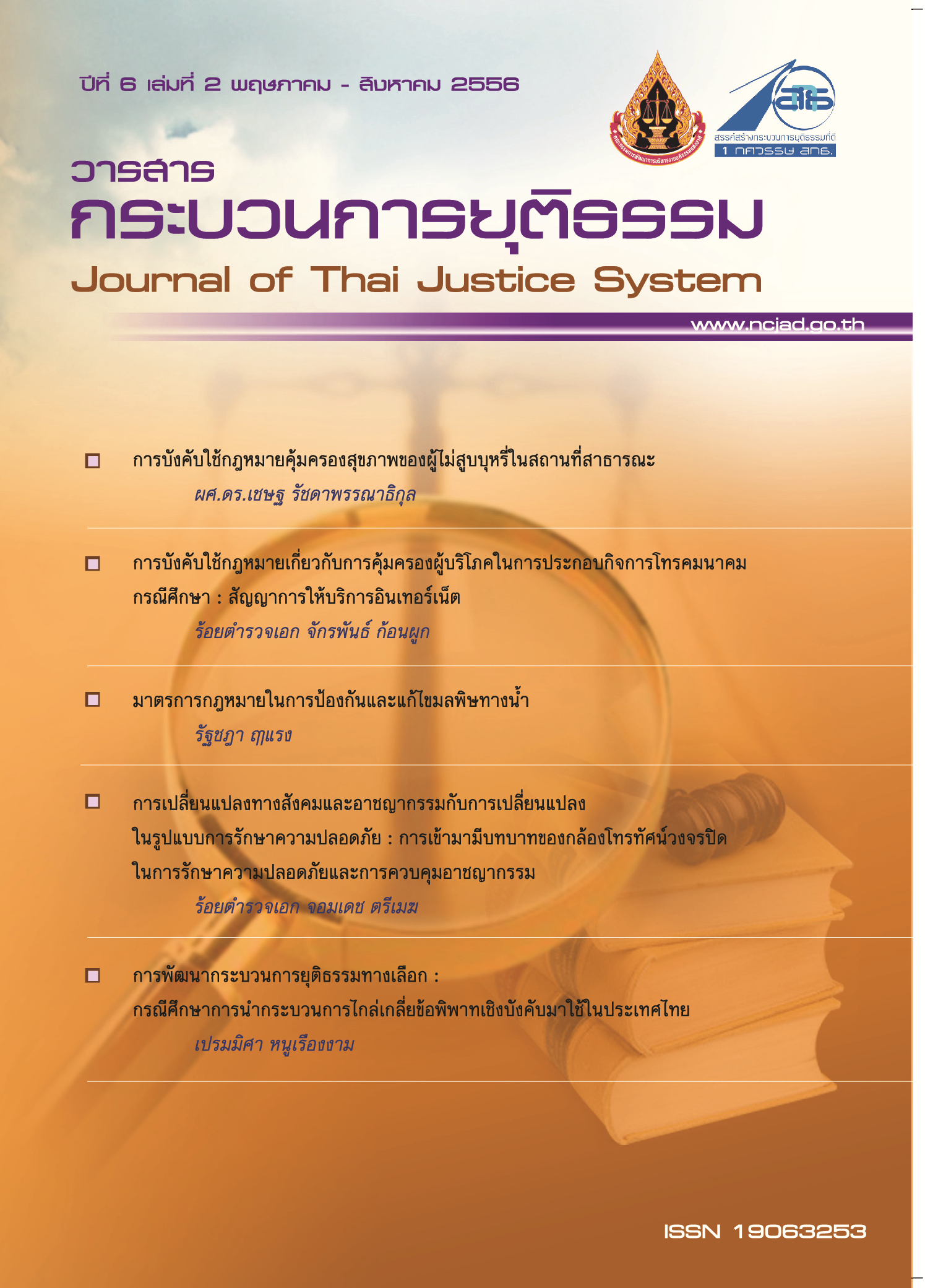การบังคับใช้กฎหมายคุ้มครองสุขภาพของผู้ไม่สูบบุหรี่ในสถานที่สาธารณะ
Main Article Content
บทคัดย่อ
การบังคับใช้กฎหมายคุ้มครองสุขภาพของผู้ไม่สูบบุหรี่ในสถานที่สาธารณะ มีวัตถุประสงค์ 1. เพื่อศึกษาผลการบังคับใช้กฎหมายคุ้มครองสุขภาพของผู้ไม่สูบบุหรี่ในสถานที่สาธารณะ 2. เพื่อศึกษาการรับรุ้ของประชาชนผู้มีส่วนได้เสีย และเจ้าพนักงานผู้เกี่ยวข้องในการบังคับใช้กฎหมายคุ้มครองสุขภาพผู้ไม่สูบบุหรี่ เครื่องมือที่ใช้ในการเก็บรวบรวมข้อมูลครั้งนี้ ได้แก่ แบบสอบถาม แบบสัมภาษณ์ และแบบสังเกตุ โดยเก็บข้อมูลกับผู้ใช้ข้อมูลหลัก คือ ประชาชนที่อยู่ในสถานที่สาธารณะ และผู้ที่เข้ามาติดต่อกิจธุระอื่นใดในสถานที่สาธารณะจำนวน 64 คน ผู้ที่ทำงานอยู่ในสถานที่สาธารณะ เจ้าของกิจการบริการ ร้านค้า จำนวน 35 คน และเจ้าหนักงานผู้เกี่ยวข้องในการปฏิบัติหน้าที่ในสถานที่สาธารณะจำนวน 8 คน รวมผู้ให้ข้อมูลทั้งสิ้น 107 คน ในพื้นที่สาธารณะเขตพระนคร จังหวัดกรุงเทพมหานครทั้งหมด 37 แห่ง
ผลการศึกษา พบว่า ประชาชน และผู้ที่เข้ามาติดต่อกิจธุระอื่นใดในสถานที่สาธารณะ มีการรับรู้เกี่ยวกับกฏระเบียบ หรือมาตรการคุ้มครองสุขภาพของผู้ไม่สูบบุหรี่ ร้อยละ 62.50 มีการปฏิบัติตามกฎหมาย ร้อยละ 100 และที่ทราบว่า สถานที่สาธารณะเป็นเขตปลอดบุหรี่มีเพียงร้อยละ 43.75 สำหรับปัญหาจากการบังคับใช้กฎหมาย พบว่า ยังไม่เคยเห็นมีใครถูกจับหรือถูกปรับเลยควรมีการบังคับใช้กฎหมายอย่างจริงจัง มีการกวดขันและเข้มงวดโดยเฉพาะสถานที่สาธารณะ เจ้าของกิจการบริการ ร้านค้า มีการรับรู้เกี่ยวกับกฎระเบียบ หรือมาตรการคุ้มครองสุขภาพของผู้ไม่สูบบุหรี่ ร้อยละ 77.14 มีการปฏิบัติตามกฎหมาย ร้อยละ 100 ส่วนใหญ่จะทราบว่า สถานที่สาธารณะเป็นเขตปลอดบุหรี่ ถึงร้อยละ 91.43 โดยทราบจากป้ายโฆษณา/ป้ายประกาศมากที่สุดร้อยละ 81.25 สำหรับปัญหาผลกระทบจากการบังคับใช้กฎหมาย พบว่า ไม่เห็นมีการบังคับใช้กฎหมาย และควรมีการจับ ปรับอย่างจริงจังและสำหรับเจ้าหนักงานผู้เกี่ยวข้องในการปฏิบัติหน้าที่ มีการรับรู้เกี่ยวกับกฎระเบียบ หรือมาตรการคุ้มครองสุขภาพของผู้ไม่สูบบุหรี่ ร้อยละ 100 สำหรับผลการบังคับใช้กฎหมาย พบว่า เจ้านักงานมีการดำเนินการอยุ๋บ้าง เช่น การตักเตือนด้วยตนเอง การแจ้งให้ผู้ดูแลสถานที่สาธารณะ นั้นๆ ตักเตือน ส่วนเจ้าพนักงานที่ไม่ดำเนินการใดๆ เลยให้เหตุผลว่าต่อเนื่องจากตนเองไม่มีอำนาจในการดำเนินการ เจ้าพนักงานส่วนใหญ่ไม่เคยได้รับเรื่องร้องเรียนเกี่ยวกับการสูบบุหรี่ในสถานที่สาธารณะ แต่มีเจ้าหนักงานบางคนที่เคยได้รับเรื่องร้องเรียนก็จะดำเนินการโดยจดบันทึกคำให้การร้องทุกข์กล่าวโทษของผู้ร้องเรียน และสงต่อให้เจ้าพนักงานผู้มีอำนาจหน้าที่ดำเนินการต่อไป สำหรับผลกระทบ ปัญหาหรืออุปสรรคในการบังคับใช้กฎหมายห้ามสูบบุหรี่ในสถานที่สาธารณะ พบว่า เจ้าพนักงานไม่มีอำนาจเบ็ดเสร็จทำได้เพียงร้องทุกข์ กล่าวโทษต่อตำรวรเพื่อให้ดำเนินการต่อไป งบประมาณในการประชาสัมพันธ์ไม่เพียงพอที่จะดำเนินการบังคับใช้กฎหมายอย่างจริงจังเนื่องจากมองว่าเป็นปัญหาเล็กน้อย สำหรับประสิทธิผลในการบังคับใช้กฎหมาย พบว่า เนื่องจากเป็นกฎหมายที่มีการออกประกาศเปลี่ยนแปลงเพิ่มเติมค่อนข้างบ่อย จึงต้องการให้มีการอบรมให้ความรู้แก่เจ้าพนักงานอย่างสม่ำเสมอ ประชาสัมพันธ์ รณรงค์ให้ประชาชนได้ทราบอย่างทั่วถึงและต่อเนื่องและต้องดำเนินการบังคับใช้กฎหมายอย่างจริงจัง
Article Details
ต้นฉบับที่ได้รับการตีพิมพ์ในวารสาร เป็นลิขสิทธิ์ของวารสารกระบวนการยุติธรรม แต่ความคิดเห็นที่ปรากฏในเนื้อหาของบทความในวารสารกระบวนการยุติธรรม ถือเป็นความรับผิดชอบของผู้เขียนแต่เพียงผู้เดียว
เอกสารอ้างอิง
ชัยวัฒน์ วงศ์วัฒนศานต์. (2531). การร่างกฎหมาย. วารสารกฎหมาย. หน้า 25-26.
เชษฐ รัชดาพรรณาธิกุล. (กันยายน 2553-กุมภาพันธ์ 2554). บุหรี่ในสถานบันเทิง : จากนโยบายสู๋การปฏิบัติ.วารสารสหศาสตร์, 10 (2).171-192
ณัฐริกา วายุภาพ. (2536). การศึกษาการบังคับใช้กฎหมายควบคุมการทิ้งขยะมูลฝอยจากชุมชนในเขตกรุงเทพหมานคร. วิทยานิพนธ์ปริญญาวิทยาศาสตรมหาบัณฑิต สาขาเทคโนโลยีการสิ่งแวดล้อมบัณฑิตวิทยาลัย มหาวิทยาลัยมหิดล.
ประกาศกระทรวงสาธารณสุข (ฉบับที่ 19) พ.ศ. 2553 เรื่อง กำหนดชื่อหรือประเภทขของสถานที่ให้มีการคุ้มครองสุขภาพของผู้ไม่สูบบุหรี่และกำหนดส่วนหนึ่งส่วนใดหรือทั้งหมดของสถานที่สาธารณะดังกล่าวเป็นเขตสูบบุหรี่หรือเขตปลอดบุหรี่รวมทั้งกำหนด สภาพ ลักษณะ และ มาตรฐานของเขตสูบบุหรี่หรือเขตปลอดบุหรี่ตามรพระราชบัญญัติคุ้มครองสุขภาพของผู้ไม่สูบบุหรี่ พ.ศ. 2535
ประกิจ วาทีสาธกกิจ. (2553). เหตุผลทางการแพทย์ บ้าน ที่ทำงาน และสถานที่สาธารณะปลอดบุหรี่. มูลนิธีรณรงค์เพื่อการไม่สูบบุหรี่.
----. (2553) 50 คำถามสำหรับผู้สูบบุหรี่และไม่สูบบุหรี่. กรุงเทพหมานคร : รักษ์พิมพ์.
ประเสริฐ สุขสบาย. (2542). ทัศนะของผู้บังคับใช้กฎหมายต่อปัญหาการบังคับใช้กฎหมายด้านสวัสดิการสังคม. สังคมสงเคราะห์ศาสตรมหาบัณฑิต บัณฑิตวิทยาลัย มหาวิทยาลัยธรมศาสตร์.
โภคิน พลกุล. (2531). ปัญหาและข้อคิดบางเรื่องจากรัฐธรรมนูญไทย. กรุงเทพมหานคร : ศูนย์การพิมพ์ พลชัย.
วิฑูรย์ อึ้งประพันธ์. (2535). กฎหมายกับการปรับปรุงพฤติกรรม. วารสารคลินิก. 8 มิถุนายน 2535.
วิษณุ เครืองาม. (2530). ปัญหาและแนวโน้มของกฎหมายเกี่ยวกับการบริหารราชการไทย ในเอกสารการสอนชุดวิชาหลักกฎหมายเกี่ยวกับการบริหารราชการไทย มสธ. กรุงเทพมหานคร : โรงพิมพ์อักษรไทย.
ศิริวรรณ พิทยรังสฤษฏ์ และ ประภาพรรณ เอี่ยมอนันต์. (2554). สรุปสถานการณ์การควบคุมการบริโภคยาสูบ ประเทศไทย พ.ศ. 2554. กรุงเทพมหานคร: เจริญดี มั่นคงการพิมพ์.
ศูนย์ข้อมูล มูลนิธิรณรงค์เพื่อการไม่สูบบุหรี่. (2554). สู่เป้าหมายประเทศไทยปลอดควันบุหรี่กับ FCTC กรอบอนุสัญญาว่าด้วยการควบคุมการบริโภคยาสูบ.
สุรชาติ ณ หนางคาย. (2546). กฎหมาย กลยุทธ์ และการประยุกต์. กรุงเทพหมานคร: สถาบัน จี.อี.ซี.
สำนักงานสถิติแห่งชาติ. (2549). สถิติสำคัญเกี่ยวกับการสูบบุหรี่ของคนไทย วิเคราะห์และข้อเสนอแนะแนวทางการแก้ไขปัญหา.
หยุด แสงอุทัย. (2538). ความรู้เบื้องต้นเกี่ยวกับกฎหมายทั่วไป. พิมพ์ครั้งที่ 1 กรุงเทพมหานคร: สำนักพิมพ์บำรุงนุกูลกิจ.
Borland R., Yong H.H., Hyland, A., Anderson, S.&Fond, G.T. (2006) Determinants and consequences of smoke-free homes: findings from the International Tobacco Control (ITC) Four Country Survey. Tob Control, 15 Suppl 3, iii 42 - 50.
Cohen J.E., De Guia, N.A., Ashley, M.J., Ferrence, R., Studlar, D.T.&Northrup, D.A. (2001) Predictors of Canadian legistors' support for public health policy interventions. Can J Public Health, 92, 188-9.
Ehlert M.B., Gumataotao, A.P., Workman, R.L., Albright, C.L.&David, A.M.(2006) Community leader support for tobacco control activities&policies on Guam. PAc Health Dialog, 13, 71-8
Henson R., Medina, L.St Clair, S., Blanke, D.,Downs, L.&Jordan, J. (2002) Clean indoor air: where , why, and how. J Law Med Ethics, 30, 75-82
Howard K.A., Ribisl, K.M., Howard-Pitney, B., Norman, G.J.&Rohrbach, L.A(2001) What factors are associated with local enforcement of laws banning illegal tobacco sales to minors? A study of 182 law enforcement agencies in California. PRev Med, 33. 63-70.
Hyland A., Higbee, C., Borland, R., Travers, M., Hastings, G.,Fong, G.T.&Cummungs, K.M. (2009) Attitudesand beliefs about second-hand smoke and smoke-free policeis in four countries: findings from the International Tobacco Control Four Country Survey. Nicotine Tob Res, 11, 642-9.
Jacobson P.D.&Wasserman, J.(1999) The implementation and enforcement of tobacco control laws: policy implications for activists and the industry. J Health Polit policy Law, 24,567-98.
Li Q., Hyland, A., O'conner, R.J.,Zhao, G., Du, L.,Li, X.&Fong, G.T.(2009) Support for smoke free poliocies among smokers and non-smokers in six cities in China. Tob Control.
Rosen L.J., Zucker, D.M., Rosen, B.J.&Connolly, G.N. (2002). Second-hand smoke levels in Israeli bars, pubs and cafes before and after implementation of smoke-free legislation. Eur J Public Health.
Thrasher J.F.,Boado, M.,Sebrie, E.M.&Bianco, E.(2009) Smoke-free policies and the social acceptability of smoking in Uruguay and Mexico: findings from the International Tobacco Control Policy Evaluation Project. Nicotine Tob Res, 11, 591-9.
Yong H.H., Foong, K., Borland, R., Omar, M., Hamann, S., Sirirassamee, B., Fong, G.T., Fotuhi, O.&Hyland, (2009).A. Support for and reported compliance among smokers with smoke-free policies in air-confitioned hospitality venues in Malaysia and Thailand: findings from the International Tobacco Control Southeast Asia Survey. Asia Pac J Public Health 22, 98-109


